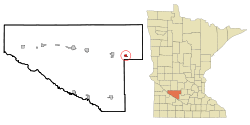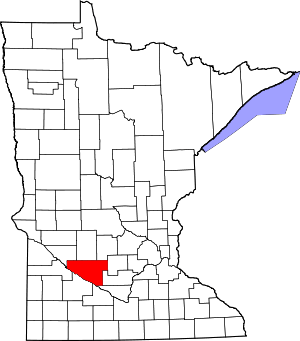Buffalo Lake, Minnesota
Buffalo Lake is a city in Renville County, Minnesota, United States. The population was 733 at the 2010 census.[6]
Buffalo Lake | |
|---|---|
Residences and a grain elevator in Buffalo Lake, Minnesota | |
 Location of Buffalo Lake, Minnesota | |
| Coordinates: 44°44′12″N 94°37′6″W | |
| Country | United States |
| State | Minnesota |
| County | Renville |
| Area | |
| • Total | 0.68 sq mi (1.77 km2) |
| • Land | 0.68 sq mi (1.77 km2) |
| • Water | 0.00 sq mi (0.00 km2) |
| Elevation | 1,070 ft (326 m) |
| Population | |
| • Total | 733 |
| • Estimate (2019)[3] | 686 |
| • Density | 1,005.87/sq mi (388.31/km2) |
| Time zone | UTC-6 (Central (CST)) |
| • Summer (DST) | UTC-5 (CDT) |
| ZIP code | 55314 |
| Area code(s) | 320 |
| FIPS code | 27-08488[4] |
| GNIS feature ID | 0640614[5] |
| Website | www.buffalolake.org |
History
Buffalo Lake was platted in 1881, and named after a nearby lake.[7] A post office has been in operation at Buffalo Lake since 1882.[8]
Geography
According to the United States Census Bureau, the city has a total area of 0.68 square miles (1.76 km2), all of it land.[9]
U.S. Route 212 serves as a main route in the city.
Demographics
| Historical population | |||
|---|---|---|---|
| Census | Pop. | %± | |
| 1900 | 389 | — | |
| 1910 | 371 | −4.6% | |
| 1920 | 468 | 26.1% | |
| 1930 | 545 | 16.5% | |
| 1940 | 637 | 16.9% | |
| 1950 | 724 | 13.7% | |
| 1960 | 707 | −2.3% | |
| 1970 | 758 | 7.2% | |
| 1980 | 782 | 3.2% | |
| 1990 | 734 | −6.1% | |
| 2000 | 768 | 4.6% | |
| 2010 | 733 | −4.6% | |
| Est. 2019 | 686 | [3] | −6.4% |
| U.S. Decennial Census[10] | |||
2010 census
As of the census[2] of 2010, there were 733 people, 288 households, and 176 families living in the city. The population density was 1,077.9 inhabitants per square mile (416.2/km2). There were 327 housing units at an average density of 480.9 per square mile (185.7/km2). The racial makeup of the city was 93.2% White, 0.3% African American, 0.3% Native American, 0.8% Asian, 3.7% from other races, and 1.8% from two or more races. Hispanic or Latino of any race were 8.3% of the population.
There were 288 households, of which 31.3% had children under the age of 18 living with them, 49.3% were married couples living together, 8.0% had a female householder with no husband present, 3.8% had a male householder with no wife present, and 38.9% were non-families. 34.7% of all households were made up of individuals, and 19.5% had someone living alone who was 65 years of age or older. The average household size was 2.35 and the average family size was 3.03.
The median age in the city was 42.4 years. 24.6% of residents were under the age of 18; 5.7% were between the ages of 18 and 24; 22.8% were from 25 to 44; 22.8% were from 45 to 64; and 24% were 65 years of age or older. The gender makeup of the city was 50.6% male and 49.4% female.
2000 census
As of the census[4] of 2000, there were 768 people, 294 households, and 197 families living in the city. The population density was 1,235.0 people per square mile (478.3/km2). There were 313 housing units at an average density of 503.3 per square mile (194.9/km2). The racial makeup of the city was 92.45% White, 0.52% Native American, 0.26% Asian, 6.64% from other races, and 0.13% from two or more races. Hispanic or Latino of any race were 9.64% of the population.
There were 294 households, out of which 32.7% had children under the age of 18 living with them, 54.8% were married couples living together, 8.2% had a female householder with no husband present, and 32.7% were non-families. 29.6% of all households were made up of individuals, and 18.4% had someone living alone who was 65 years of age or older. The average household size was 2.43 and the average family size was 2.96.
In the city, the population was spread out, with 24.7% under the age of 18, 6.8% from 18 to 24, 25.4% from 25 to 44, 17.1% from 45 to 64, and 26.0% who were 65 years of age or older. The median age was 40 years. For every 100 females, there were 87.3 males. For every 100 females age 18 and over, there were 84.7 males.
The median income for a household in the city was $40,000, and the median income for a family was $43,958. Males had a median income of $31,250 versus $25,000 for females. The per capita income for the city was $17,669. About 5.6% of families and 10.8% of the population were below the poverty line, including 17.6% of those under age 18 and 6.2% of those age 65 or over.
References
- "2019 U.S. Gazetteer Files". United States Census Bureau. Retrieved July 26, 2020.
- "U.S. Census website". United States Census Bureau. Retrieved 2012-11-13.
- "Population and Housing Unit Estimates". United States Census Bureau. May 24, 2020. Retrieved May 27, 2020.
- "U.S. Census website". United States Census Bureau. Retrieved 2008-01-31.
- "US Board on Geographic Names". United States Geological Survey. 2007-10-25. Retrieved 2008-01-31.
- "2010 Census Redistricting Data (Public Law 94-171) Summary File". American FactFinder. United States Census Bureau. Retrieved 27 April 2011.
- Upham, Warren (1920). Minnesota Geographic Names: Their Origin and Historic Significance. Minnesota Historical Society. p. 456.
- "Renville County". Jim Forte Postal History. Archived from the original on 21 January 2016. Retrieved 5 August 2015.
- "US Gazetteer files 2010". United States Census Bureau. Archived from the original on 2012-01-25. Retrieved 2012-11-13.
- "Census of Population and Housing". Census.gov. Retrieved June 4, 2015.
